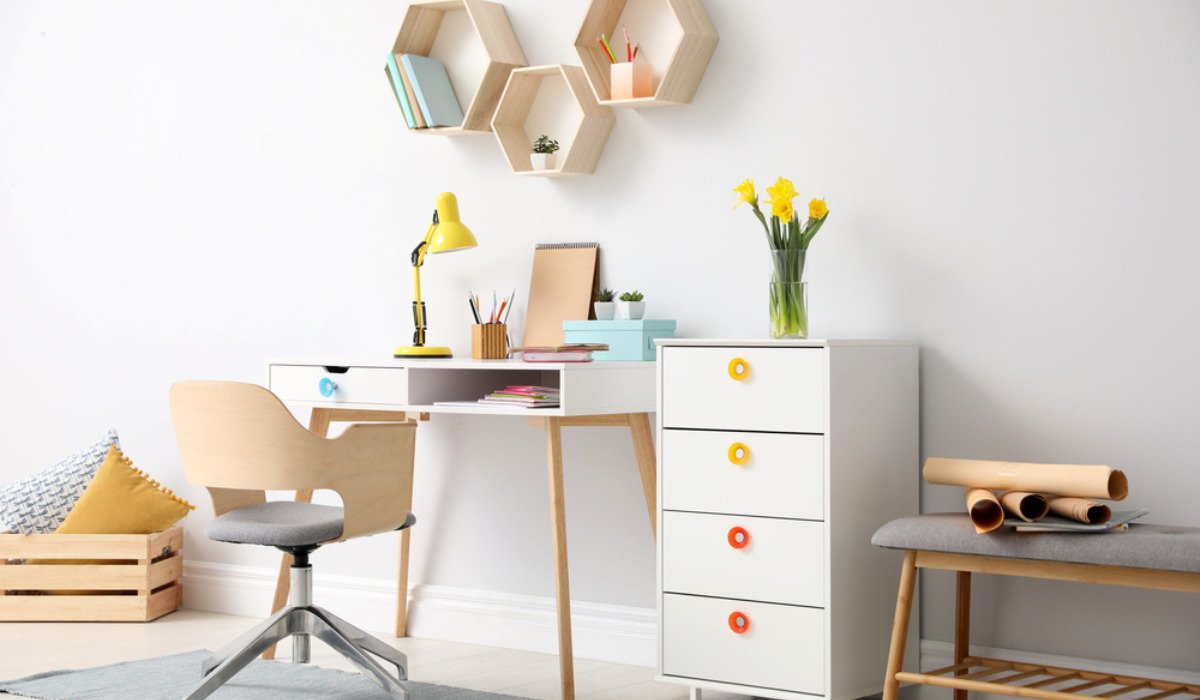Study rooms have gained popularity as essential home additions. According to colour psychology experts, specific colours are deemed ideal for study rooms, while Vastu specialists advise against certain dark hues in this space. Numerous thematic and colour combinations can help boost motivation and productivity. Ensuring that your study room aligns with Vastu principles, colour psychology is vital, especially for families with children. In this article, we would explore the most effective colour combination for your study room.
Top colour combinations for study room
Check these amazing study room colour combinations for home.
White and beige study room colour combination
An ideal colour scheme for student rooms, as recommended by Vastu principles, is beige and white. The pairing of beige and white has gained significant popularity due to its contemporary appeal. These hues offer a subtle touch, creating an illusion of increased space and elegance within the room. This colour combination is especially well-suited for compact study space and home offices.

Source: Ezymore (Pinterest)
Cream and white colour combination for study room
This colour combination is among the most calming options for a study room. If you often work or study late in nights, this colour scheme is an excellent choice. It is gentle on eyes and provides just the right amount of brightness, thanks to the natural light in your study room. White is reflective, and when combined with cream, it creates a space that efficiently harnesses natural sunlight, eliminating the need for additional reflectors.

Source: CRZ Designs (Pinterest)
White and yellow colours for study room
Yellow is a colour known for its ability to instantly brighten any space. It is often considered an excellent choice for a study room, but some individuals may find it a bit too vibrant. Striking a balance is key, which is why a combination of yellow and white is often recommended for a study room. Consider this study room painting idea: paint one wall with a partial yellow hue while keeping the rest of the walls white. This approach achieves a harmonious blend of energy and serenity in the room. Furthermore, yellow serves as an ideal study room colour, providing an inspiring backdrop for hanging motivational quotes.

Source: Hunker (Pinterest)
Lavender and grey study room colours
Various shades of purple, whether light or dark, can introduce a splendid ambiance to any room. Combining lavender with a soft shade of grey provides your study room with a colour palette reminiscent of the refreshing morning dew. Additionally, this colour combination is versatile and suitable for all age groups, making it equally suitable for a child’s study space and a home office.

Source: Nylon Living (Pinterest)
Grey and white study room colour combination
White is a widely favoured wall colour due to its versatility in complementing other hues and allowing them to shine. The combination of white cabinetry against a solid grey wall, all set against a backdrop of wooden flooring, creates a sleek and contemporary ambiance. This choice is particularly excellent if you intend to use the study room as a multifunctional space, as it exudes a modern and sophisticated aesthetic.

Source: The Cotswold Company (Pinterest)
Pastel pink and white colour combination for study rooms
For those seeking elegant study room colour ideas, pastel pink and white make an excellent choice. This colour combination offers a subtle yet illuminating effect in a room. A canvas painting featuring flowers or natural scenes would be an ideal wall decor choice for this study room. As per current interior design trends, pastel pink is highly regarded as the top wall colour for study rooms. However, if this shade doesn’t resonate with your preferences, there are various other pastel shades available to suit your study room’s colour scheme.

Source: Xiomara Gregory (Pinterest)
Aqua blue and white colours for study rooms
Consider a serene wall colour combination of white and blue for your study rooms. This pairing is a fantastic choice for study rooms, especially in smaller space or integrated study areas. White exudes a sense of tranquillity and sophistication, while blue adds a touch of vibrancy to the overall colour scheme. This combination creates a refreshing ambiance that can truly elevate your study space within a room.

Source: Moumita Dasgupta (Pinterest)
White and red study room colours
Red may not be the initial choice for many when selecting a study room colour, but it can be effectively paired in several ways. One approach is to paint a single wall of the room red while keeping the others white, creating a harmonious balance of energies. For the best results in a study room, it’s advisable to opt for a matte finish red paint, as excessive gloss on such a vibrant colour can be distracting. If you choose to proceed with this concept, consider painting the wall that doesn’t directly face your desk. Another way to incorporate the red and white colour combination is to apply these hues to different walls.

Source: Miss jamie Schmidt (Pinterest)
Brown and grey study room colour combination
A study room adorned in light brown and grey fosters creativity and enhances your ability to focus on your tasks. This combination establishes an environment that is both tranquil and conducive to productivity, all while exuding a stylish and sophisticated appeal.

Source: Anna Hewitson Design
Pale green and grey colour combination for study rooms
Green is a colour that invokes a sense of nature, imparting a soothing and tranquil atmosphere while you work. This hue symbolises motivation, and when combined with grey, it introduces a stylish element to any space, making it an ideal colour combination for your study room.

Source: Design Cafe
Best study room colours as per Vastu
In accordance with Vastu Shastra, selecting the right colours for each room in your home, including the study room, is crucial. While personal preferences are important, adhering to Vastu principles can foster harmony and positive energy within your study space. Here are some of the top colours recommended for study rooms according to Vastu.
- Yellow: Yellow, which is associated with wisdom and optimism, is also considered auspicious for study rooms. It can improve concentration levels and mental clarity, creating an environment conducive to learning.
- Green: Vastu advocates for the use of green in study rooms, as it symbolises growth and rejuvenation. This colour has the potential to stimulate learning and aid in retaining knowledge.
- Blue: Light shades of blue are in harmony with Vastu principles, as they evoke the essence of the sky and cultivate a serene and focused atmosphere.
Study room colours to avoid as per Vastu
According to Vastu principles, it is recommended to avoid using the following colours in your study room:
- Black: Using black as a primary wall colour for the study room should be avoided, as it can create a gloomy and depressing atmosphere, which is not conducive to learning.
- Dark grey: Dark shades of grey may evoke feelings of melancholy and dreariness, making them unsuitable for the colour scheme of a study room.
- Red: Vastu advises against using red in study rooms, as it can be overly stimulating and distracting, hindering concentration and focus.
Study room Vastu tips
If you wish to adhere to Vastu principles for your study room and desk arrangement, consider the following aspects:
- The orientation of the study room should ideally be in the west, north, or southwest.
- Ensure there is an open space in front of the study table, as it promotes mental clarity.
- While studying, face east or north as cosmic energy waves from these directions are believed to be beneficial.
- Modern study tables are often modest, and wall mounted. However, avoid placing a study table in a way that a wall is directly in front of it. Such an arrangement, with projecting cabinets and a wall in front, can disrupt a child’s ability to focus on his studies. It’s advisable to avoid this setup.
- Position a table close to a wall but ensure there are no cabinets projecting outward.
- Keep the study space vibrant, tidy, and clean. Place a pyramid made of copper, plastic, or crystal along with images of the deities you believe in on the study table.
- When studying, it’s recommended to sit with your back to the north-east direction, leaving space in the front north-east.
- Provide strong support for your back while studying.
- Avoid sitting beneath any beams or projecting cabinets while studying, as these can create intense pressure and hinder focus and concentration.
- A study room with a wall towards the north-east can be advantageous.
- If possible, face the north or east instead of a window overlooking a busy street.
- Change your seating arrangement if sitting in the north-west direction makes it difficult to focus.
- It’s generally more beneficial to face the north-east direction while studying, as it may require less effort and yield better results.
- If there are any inherent flaws in the north-east direction, consider implementing remedial measures to address them.
Housing.com POV
Selecting the right colours for your study room is crucial for creating an environment that fosters productivity, concentration, and positivity. Colour combinations play a significant role in enhancing motivation and creating a harmonious atmosphere in your study space. Whether you choose to follow Vastu principles or opt for colours based on their psychological effects, there are various options available to suit your preferences and requirements. From calming neutrals to energising hues, the key is to create a space that reflects your personality and supports your academic or professional pursuits. By incorporating the recommended colour combinations and following Vastu tips for arranging your study room, you can create a conducive environment for learning, creativity, and intellectual growth.
FAQs
Which is the best colour for a study room?
A neutral and light colour scheme is often considered the best choice for study rooms. Neutral colours, such as white, grey, and beige are known for their calming qualities, creating a relaxed atmosphere that promotes concentration. These hues also have the added benefit of making the room feel more spacious and diffusing natural light effectively.
How do you colour a study room?
Painting a study room with your chosen colours is a straightforward task. You can either choose to do it yourself or hire a professional to save time and effort.
Which colour is used in the study room as per Vastu?
According to Vastu, colours like green, pastel blue, cream, light-green and white are all excellent picks for a study room. These colours are believed to have a soothing effect on the mind, which helps you concentrate. It is advisable to avoid dark colours tables as they do not exude positive energy, as per Vastu principles.
Which colour improves memory?
Research suggests that blue and red are the most effective colours for boosting cognition and brain function, with red being particularly beneficial for memory retention. The societal perception of the colour red may contribute to its impact on memory.
Which colour is the most motivational?
Orange is often associated with motivation, enthusiasm, and a positive attitude. Although it should be used thoughtfully as it can be overpowering.
Which colour is not good for a study room?
Vastu recommends avoid dark tones in a study room.
Does room colour affect study?
Yes, room colours can have an impact on study. Studies have shown that colour can influence a student's perception of time and attention. Different colours can stimulate the brain, potentially fostering visual thinking, creativity, problem solving and learning.
Which colour attracts positivity?
Yellow is often seen as a symbol of happiness and warmth in many cultures. It's a colour that tends to grab people's attention more than any other colour, and it is associated with positive vibes.
| Got any questions or point of view on our article? We would love to hear from you. Write to our Editor-in-Chief Jhumur Ghosh at [email protected] |

Dhwani is a content management expert with over five years of professional experience. She has authored articles spanning diverse domains, including real estate, finance, business, health, taxation, education and more. Holding a Bachelor’s degree in Journalism and Mass Communication, Dhwani’s interests encompass reading and travelling. She is dedicated to staying updated on the latest real estate advancements in India.
Email: [email protected]











